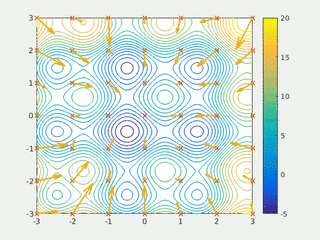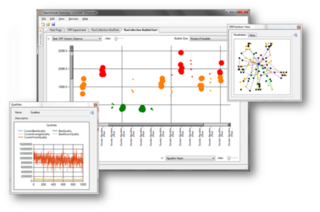Related Research Articles

In computer science and operations research, a genetic algorithm (GA) is a metaheuristic inspired by the process of natural selection that belongs to the larger class of evolutionary algorithms (EA). Genetic algorithms are commonly used to generate high-quality solutions to optimization and search problems by relying on biologically inspired operators such as mutation, crossover and selection. Some examples of GA applications include optimizing decision trees for better performance, solving sudoku puzzles, hyperparameter optimization, causal inference, etc.

In computational intelligence (CI), an evolutionary algorithm (EA) is a subset of evolutionary computation, a generic population-based metaheuristic optimization algorithm. An EA uses mechanisms inspired by biological evolution, such as reproduction, mutation, recombination, and selection. Candidate solutions to the optimization problem play the role of individuals in a population, and the fitness function determines the quality of the solutions. Evolution of the population then takes place after the repeated application of the above operators.
In computer science, evolutionary computation is a family of algorithms for global optimization inspired by biological evolution, and the subfield of artificial intelligence and soft computing studying these algorithms. In technical terms, they are a family of population-based trial and error problem solvers with a metaheuristic or stochastic optimization character.

In computational science, particle swarm optimization (PSO) is a computational method that optimizes a problem by iteratively trying to improve a candidate solution with regard to a given measure of quality. It solves a problem by having a population of candidate solutions, here dubbed particles, and moving these particles around in the search-space according to simple mathematical formula over the particle's position and velocity. Each particle's movement is influenced by its local best known position, but is also guided toward the best known positions in the search-space, which are updated as better positions are found by other particles. This is expected to move the swarm toward the best solutions.
Global optimization is a branch of applied mathematics and numerical analysis that attempts to find the global minima or maxima of a function or a set of functions on a given set. It is usually described as a minimization problem because the maximization of the real-valued function is equivalent to the minimization of the function .
In computer science and mathematical optimization, a metaheuristic is a higher-level procedure or heuristic designed to find, generate, tune, or select a heuristic that may provide a sufficiently good solution to an optimization problem or a machine learning problem, especially with incomplete or imperfect information or limited computation capacity. Metaheuristics sample a subset of solutions which is otherwise too large to be completely enumerated or otherwise explored. Metaheuristics may make relatively few assumptions about the optimization problem being solved and so may be usable for a variety of problems.
A memetic algorithm (MA) in computer science and operations research, is an extension of the traditional genetic algorithm (GA) or more general evolutionary algorithm (EA). It may provide a sufficiently good solution to an optimization problem. It uses a suitable heuristic or local search technique to improve the quality of solutions generated by the EA and to reduce the likelihood of premature convergence.
Grammatical evolution (GE) is an evolutionary computation and, more specifically, a genetic programming (GP) technique (or approach) pioneered by Conor Ryan, JJ Collins and Michael O'Neill in 1998 at the BDS Group in the University of Limerick.
ParadisEO is a white-box object-oriented framework dedicated to the flexible design of metaheuristics. It uses EO, a template-based, ANSI-C++ compliant computation library. ParadisEO is portable across both Windows system and sequential platforms. ParadisEO is distributed under the CeCill license and can be used under several environments.
Parallel metaheuristic is a class of techniques that are capable of reducing both the numerical effort and the run time of a metaheuristic. To this end, concepts and technologies from the field of parallelism in computer science are used to enhance and even completely modify the behavior of existing metaheuristics. Just as it exists a long list of metaheuristics like evolutionary algorithms, particle swarm, ant colony optimization, simulated annealing, etc. it also exists a large set of different techniques strongly or loosely based in these ones, whose behavior encompasses the multiple parallel execution of algorithm components that cooperate in some way to solve a problem on a given parallel hardware platform.
A hyper-heuristic is a heuristic search method that seeks to automate, often by the incorporation of machine learning techniques, the process of selecting, combining, generating or adapting several simpler heuristics to efficiently solve computational search problems. One of the motivations for studying hyper-heuristics is to build systems which can handle classes of problems rather than solving just one problem.
Universal Darwinism, also known as generalized Darwinism, universal selection theory, or Darwinian metaphysics, is a variety of approaches that extend the theory of Darwinism beyond its original domain of biological evolution on Earth. Universal Darwinism aims to formulate a generalized version of the mechanisms of variation, selection and heredity proposed by Charles Darwin, so that they can apply to explain evolution in a wide variety of other domains, including psychology, linguistics, economics, culture, medicine, computer science, and physics.
In applied mathematics, multimodal optimization deals with optimization tasks that involve finding all or most of the multiple solutions of a problem, as opposed to a single best solution. Evolutionary multimodal optimization is a branch of evolutionary computation, which is closely related to machine learning. Wong provides a short survey, wherein the chapter of Shir and the book of Preuss cover the topic in more detail.
Natural computing, also called natural computation, is a terminology introduced to encompass three classes of methods: 1) those that take inspiration from nature for the development of novel problem-solving techniques; 2) those that are based on the use of computers to synthesize natural phenomena; and 3) those that employ natural materials to compute. The main fields of research that compose these three branches are artificial neural networks, evolutionary algorithms, swarm intelligence, artificial immune systems, fractal geometry, artificial life, DNA computing, and quantum computing, among others.

HeuristicLab is a software environment for heuristic and evolutionary algorithms, developed by members of the Heuristic and Evolutionary Algorithm Laboratory (HEAL) at the University of Applied Sciences Upper Austria, in Hagenberg im Mühlkreis. HeuristicLab has a strong focus on providing a graphical user interface so that users are not required to have comprehensive programming skills to adjust and extend the algorithms for a particular problem. In HeuristicLab algorithms are represented as operator graphs and changing or rearranging operators can be done by drag-and-drop without actually writing code. The software thereby tries to shift algorithm development capability from the software engineer to the user and practitioner. Developers can still extend the functionality on code level and can use HeuristicLab's plug-in mechanism that allows them to integrate custom algorithms, solution representations or optimization problems.
The Genetic and Evolutionary Computation Conference (GECCO) is the premier conference in the area of genetic and evolutionary computation. GECCO has been held every year since 1999, when it was first established as a recombination of the International Conference on Genetic Algorithms (ICGA) and the Annual Genetic Programming Conference (GP).

The following outline is provided as an overview of and topical guide to machine learning. Machine learning is a subfield of soft computing within computer science that evolved from the study of pattern recognition and computational learning theory in artificial intelligence. In 1959, Arthur Samuel defined machine learning as a "field of study that gives computers the ability to learn without being explicitly programmed". Machine learning explores the study and construction of algorithms that can learn from and make predictions on data. Such algorithms operate by building a model from an example training set of input observations in order to make data-driven predictions or decisions expressed as outputs, rather than following strictly static program instructions.
Memetic computing is a novel computational paradigm that incorporates the notion of meme(s) as basic units of transferable information encoded in computational representations for boosting the performance of artificial evolutionary systems in the domain of search and optimization.
References
- ↑ M. Omran, A novel cultural algorithm for real-parameter optimization. International Journal of Computer Mathematics, doi : 10.1080/00207160.2015.1067309, 2015.
- Robert G. Reynolds, Ziad Kobti, Tim Kohler: Agent-Based Modeling of Cultural Change in Swarm Using Cultural Algorithms
- R. G. Reynolds, “An Introduction to Cultural Algorithms, ” in Proceedings of the 3rd Annual Conference on Evolutionary Programming, World Scientific Publishing, pp 131–139, 1994.
- Robert G. Reynolds, Bin Peng. Knowledge Learning and Social Swarms in Cultural Systems. Journal of Mathematical Sociology. 29:1-18, 2005
- Reynolds, R. G., and Ali, M. Z, “Embedding a Social Fabric Component into Cultural Algorithms Toolkit for an Enhanced Knowledge-Driven Engineering Optimization”, International Journal of Intelligent Computing and Cybernetics (IJICC), Vol. 1, No 4, pp. 356–378, 2008
- Reynolds, R G., and Ali, M Z., Exploring Knowledge and Population Swarms via an Agent-Based Cultural Algorithms Simulation Toolkit (CAT), in proceedings of IEEE Congress on Computational Intelligence 2007.